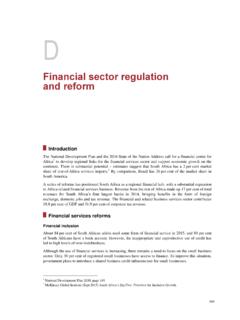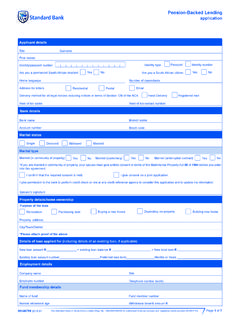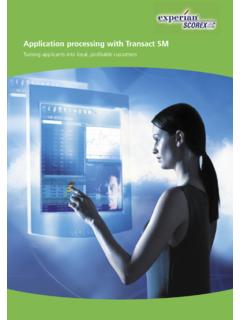Transcription of ANALYSIS OF THE FINANCIAL INSTITUTIONS’ …
1 ANALYSIS OF THE FINANCIAL institutions strategic E-BUSINESS SECURITY SOLUTIONS: TECHNICAL AND NON-TECHNICAL Norman Tinyiko Baloyi ISACA, ISC2 Box 28289 Sunnyside 0132 27 12 678 7575 ABSTRACT Many FINANCIAL institutions are now realizing that information technology is enabling business, not just supporting it. For this reason, FINANCIAL sectors are changing the way they operate to capitalize on this trend by conducting their day-to-day business operations, namely, business-to-business (B2B) and business-to-consumer (B2C) using online applications. The proliferation of e-business and the widespread distribution of systems have created significant challenges for managing security and availability of systems. These challenges result out of a lack of uniformity and integration in the management of information across heterogeneous systems and locations.
2 To address e-business challenges, an in-depth literature review was conducted to analyse the FINANCIAL institutions in south africa using existing models. Industry ANALYSIS model was used as the underlying model in analysing the FINANCIAL industry forces that are rapidly changing due to new emerging online technologies and intermediaries that are instrumental in driving these changes. Competitor ANALYSIS model was used to understand how FINANCIAL banking and insurance institutions secure their e-business. E-business strategies such as B2Bs and B2Cs require extensive system integration. To achieve the value proposition these strategies provide, FINANCIAL institutions need to knit together many systems to provide secure enablement. In this study, an integrated framework approach is applied since the concept of integrated security is emerging as an effective approach to address the new challenges facing e-business.
3 KEY WORDS E-business, business-to-business, business-to-consumer, FINANCIAL institution, industry ANALYSIS , competitor ANALYSIS , information system, personal identification number (PIN), keypad, public key infrastructure (PKI) ANALYSIS OF THE FINANCIAL institutions strategic E-BUSINESS SECURITY SOLUTIONS: TECHNICAL AND NON-TECHNICAL 1 INTRODUCTION The FINANCIAL services market in south africa is an overcrowded market in which the banking industry is dominated by the Big Four : ABSA, FirstRand, Nedcor and Standard Bank, followed closely by Investec and BoE. These banks account for over 90% of retail market. Approximately 90% foreign banks are wholly focused on merchant banking and the investment completes the picture (Baloyi, 2005). The insurance industry is dominated by four major companies, Old Mutual, Sanlam, Liberty Life, and Momentum.
4 This insurance industry has been characterised by mergers and take-overs. FINANCIAL institutions have conducted their business online since the late 1960s through closed, private networks (Deloitte & Touch , 2002). Online FINANCIAL services include banking, brokerage, life and other retail insurance, retirement and estate planning, funds provision, mortgages, credit cards, and much more. In today s business environment, FINANCIAL institutions potentially deal with millions of customers, many of whom they may never even see face to face. The winning FINANCIAL services providers may ultimately be those which can provide a one-stop service and which can draw on their customers database more efficiently and effectively to support cross-selling. Many FINANCIAL institutions are now realizing that information technology is enabling business, not just supporting it.
5 For this reason, FINANCIAL sectors are changing the way they operate to capitalize on this trend by conducting their day-to-day business operations, namely, business-to-business (B2B) and business-to-consumer (B2C) using online applications. B2B deals with the type of transactions between businesses using Internet as a commercial medium. B2C deals with the transactions between business and consumers which involve electronic payment. In terms of e-commerce, B2B transaction is more likely to give rise to the incidence of procurement fraud whereas B2C transaction is more likely to give rise to losses caused by credit card fraud, identity fraud, and the consequential charge backs imposed upon businesses by credit card companies (Philippsohn and Thomas, 2003). As organizations rush to build and support e-commerce applications there is an increasing realization that information and FINANCIAL assets are becoming more vulnerable to attack (Lichtenstein, 2000).
6 The confirmation of this is that Visa, Mastercard, Discover FINANCIAL Services and American Express have admitted that they have all had credit card data compromised (Computer Fraud & Security, March 2003). This is the reason why consumers are concerned by the security and accuracy of electronic information held by third parties because of the perceived ease of access. For the highest standards of service and convenience, these consumers require secure Web access to companies back-office systems to assess their status, make purchases, and much more. Enterprises must earn the trust of their customers, their business partners and the regulators. As such, security and technology will be the key in open electronic communities. Attempting to build this trusted or secure e-Business environment will require hard work and can be very time consuming. One slip can cause damage well beyond any immediate economic loss.
7 The challenge is to ensure that security solutions are not used as a stand-alone solution but they are integrated to provide an economic and effective solution. When managed properly, this integrated solution can provide a sound basis to deploy new services quickly to support changing business processes, volumes and customer expectations. This paper starts by identifying major risks and their countermeasures faced by FINANCIAL institutions (section 2), analyses the secure e-business solutions in the FINANCIAL institutions (section 3) and provides the process-oriented approach into securing e-business (section 4). Future research and conclusions conclude the paper. 2 MAJOR RISKS FACED BY FINANCIAL institutions FINANCIAL institutions are faced with different types of risks that can severely impact the efficient and effective operations of the business.
8 These risks are: theft of customer identity by employees, identity theft, credit card fraud, business interruption, insufficient internal staff training, internal staff compromise, inadequate customer education and awareness, breaches of legislation, and Web spoofing (Baloyi, 2005). This section discusses these risks and countermeasures. Theft of customer identity / information by employees Most computer fraud is committed from within the organization (Bequai, 1998), because opportunities are presented through lax security. Customer data is extremely valuable to criminals and competitors and can be stolen by internal staff for personal gain or selling to competitors. The possibility of theft is due to hacking or security control loopholes. Theft of customer information is expensive to recover and repair since it contains reputation damage and loss of customer confidence.
9 Deterrence measures and culture of security consciousness and respect can reduce malicious behaviour of the employees. Deterrence measures are attempts to discourage people from criminal behaviour through fear of sanctions. Sanctions are effective if people know that they will definitely be punished for the crime or anti-social acts and that the punishment will be harsh. In the context of information systems (IS) security, deterrence efforts are policy statements and guidelines on legitimate use of IS assets, security briefings on the consequences of illegitimate use of IS assets, and audits on the use of IS assets. Visible deterrent efforts ( writings on notice boards or after signing on computer systems etc.) are effective active measures that can reduce IS abuses by convincing potential abusers that the probability of getting caught is high. Deterrence efforts are particularly effective if the punishment for IS abuses is also severe.
10 Identity theft In identity theft risk, a fraudster utilizes sophisticated software to record keystrokes on a customer's personal computer, which sends customers information to the fraudster, enabling the fraudster to analyse the sent information and identify possible access to account numbers and PINs. Using this information, the fraudster can then signs on to Internet Banking as a legitimate customer and defraud the customer. This was the case with ABSA bank fraudster in 2003 (Granova and Eloff, 2004), where the spyware software was attached to an email and defrauded R530,000 of 10 ABSA clients. In 2002, the personal computers of 21 customers of Development Bank of Singapore, Singapore s largest bank with 370 000 online banking customers, were breached on the same day to obtain PINs and IDs (Computer Fraud & Security, September 2002).








